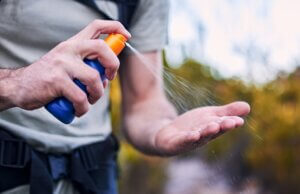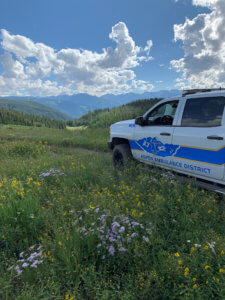As the winter snow melts, vast hiking trail systems throughout the West start to emerge. There’s something undeniably inviting about a walk along hillsides or into the mountains. It’s nature’s invitation to go a little higher, explore a little deeper, and discover that bird’s eye view of your favorite peaks, creeks and valleys. If the mountains are calling, then it’s time to brush off the hiking equipment, pull out the water bottle and sunscreen, and make sure you’re ready for this year’s season of wander and wonder with this guide to hiking injuries—how to prevent them and treat them if they happen.
Preparation: The Key to Safe Hiking
While it can be a very minimalistic sport, a successful hiking adventure still requires the right gear and preparation. It’s important to make sure your equipment fits properly—no one likes blisters! Beyond proper fit, you want to choose products and apparel that will stand up to the elements you might encounter along the way, be it high-altitude conditions, prolonged sun exposure or limited water supplies. Talk with your local outfitter or sporting goods shop to learn more about the best hiking equipment for your adventure. Then, make sure you have everything you need to reach your hiking destination. Here are some packing essentials to bring on every hike:
 Appropriate footwear
Appropriate footwear
Make sure your shoes or boots fit properly. If you bought a new pair for this year’s hiking season, give them a test drive with a few trips around town to make sure you don’t notice any hot spots before you hit the trail.
Water
Proper hydration is essential to a happy hike. Pack plenty of H2O, or make sure you have a purification system that will allow you to refill water bottles and bladders along the way.
Map, compass and/or GPS
Spend some time researching your route before you go, then ensure you have adequate wayfinding sources with you on your hike. Back up modern technology and apps with good, old-fashioned printed maps and a compass.
Food
Depending on how far you plan on hiking, packing enough calorie-dense, nourishing food is important. Complement savory sandwiches and wraps with sweet treats to keep you trekking all day long.
Proper layers
Spring and summer weather can change quickly in the high alpine, so you want to dress accordingly. Even if the forecast calls for sunshine, be prepared with additional layers, a rain jacket, windbreaker, hat and anything else that might come in handy if the weather turns quickly. Light layers are also a great way to protect yourself from the more intense sun rays you encounter as you gain elevation.
First aid kit
Don’t leave home without first aid kit essentials. These will vary depending on the length of your hike and the terrain you plan to travel. Some must-haves include:
-
- Bandages and blister treatment
- Pain relievers
- Bite and scratch ointments
- Small splint system
- EpiPen® or other allergy relief measures
 Sun protection
Sun protection
Even on a cloudy day, the sun’s rays can leave a mark, especially as you go higher into the mountains. Pack sunscreen, sunglasses, a hat and appropriate light layers to protect your skin and eyes.
Additional safety items
These can be more personal, depending on your hiking experience and comfort level. Some items to consider are a multi-tool or small, packable knife, whistle, reflective mirror, headlamp, and lighter or matches.
Hiking poles
While these certainly aren’t mandatory, they can come in handy, helping with balance if you’ll be doing a longer hike that features uneven terrain or water crossings.
Techniques for Injury Prevention
 Before you hit the trail, it’s a good idea to warm up your muscles and talk through the plan for the day with your hiking partners. If you’re planning on venturing alone, make sure someone knows your location, when to expect you home, and who to contact if there’s an emergency.
Before you hit the trail, it’s a good idea to warm up your muscles and talk through the plan for the day with your hiking partners. If you’re planning on venturing alone, make sure someone knows your location, when to expect you home, and who to contact if there’s an emergency.
To get started, show your body some love by doing some basic stretching at the trailhead, paying particular attention to your legs and lower back. Toe touches, lunge stretches and heel drops to stretch your calf muscles are good go-tos. If you’re carrying a pack, spend some time warming up your shoulders with small and large shoulder circles, and give your body a break throughout the hike by taking off the pack from time to time.
When it’s time to hit the trail, make sure you understand the terrain you’ll be traveling. Are you walking near or through water? Does your hike require any boulder scrambling, navigating a scree field or backcountry bridge crossings? Knowing what to expect out of your hike will help you choose the proper equipment and ensure you plan accordingly for time in the backcountry and conditions.
Once you’re putting one foot in front of the other, you want to listen to your body’s signals to know when it’s time to rest, hydrate and refuel. It can be easy to become focused on the rhythm of a hike, forgetting to take frequent breaks. But allowing your body short rests to recoup as needed helps ensure your day will remain fun and injury-free.
Understanding Common Hiking Injuries
Most hiking injuries are treatable on the trail, especially once you know how to recognize them and prepare for your adventure accordingly. Here are some of the most common hiking injuries and how to treat them:
 Sprains and strains
Sprains and strains
This unfortunate reality of hiking happens to even the most experienced mountain athletes. A quick roll of the ankle can thwart a day’s mission quickly. Help prevent sprains and strains in the backcountry by wearing the proper, adequately supportive footwear and paying close attention to roots and rocks when walking.
Blisters
It’s worth repeating; no one likes hot spots! These small but painful skin rubs can quickly present larger issues if not treated properly. Make sure you address a blister as soon as you feel it develop. Keep the area dry and protected with moleskin or other barriers, and pack enough clean socks to allow for frequent changes if needed.
Sunburn and heat exhaustion
These two can frequently go hand-in-hand when you’re in the high country. Wear layers with sun barrier properties (check tags for UPF ratings), and apply and reapply sunscreen every two hours, or more frequently if you’re sweating or wading through water. If you or someone in your group is suffering from heat stroke, find shade or cool water as soon as possible. Use hats or bandanas to fan the hiker and help bring their body temperature down. Make sure to drink plenty of water, preferably with electrolytes. If heat exhaustion appears to be severe, seek medical help as quickly as possible.
Insect bites and stings
Dealing with unwanted visitors on the hiking trail is a pretty common occurrence as the weather warms and dormant bugs and insects buzz back to life. To help deal with bites and stings, pack over-the-counter anti-itch ointments and pain relievers. Soaking the affected area in cold water can help reduce swelling and aggravation. If you or someone in your group has a known allergy to bees or other insects, make sure to bring an EpiPen® or other anti-allergy medication with you.
Fractures and dislocations
While less common, a bone fracture or dislocation in the backcountry can become problematic very quickly. If you plan to cruise through uneven terrain or more difficult trails, pack a splint system and understand the basic first aid for treating these injuries. Severe breaks and dislocations can require emergency evacuations, so consider packing a satellite communication device that can contact EMS if needed.
Take a preparation class
It’s a good idea to take a basic first aid and CPR class before hiking season begins. If this is the summer you plan to tackle that first ultra marathon or spend significant time in the mountains, it might be worth looking into a more advanced wilderness first aid course. Recognizing the symptoms and severity of backcountry injuries can help with the most appropriate immediate treatment and any longer-term medical assistance.
Emergency Situations: When to Seek Help
 Venturing into the mountains for a beautiful summer hike is an incredibly rewarding way to travel. However, it’s important to be extra prepared when you do. Here are three key safety measures to think about and talk through with your group before you leave the trailhead:
Venturing into the mountains for a beautiful summer hike is an incredibly rewarding way to travel. However, it’s important to be extra prepared when you do. Here are three key safety measures to think about and talk through with your group before you leave the trailhead:
Recognizing signs of serious injury
Turn to your recent first aid class, apps or even a pre-hike internet search to know when you or someone in your group is in distress.
Emergency communication
We wander into the hills to escape the pressures of daily life, but the peace and quiet of the mountains can also mean it’s harder to reach emergency services if needed. Develop a communication plan before you go, making sure to tell a family member or friend your plan for the trip and when you intend to be back within communication range. In addition, outline the steps you and your group can take if there is a backcountry emergency, including how to contact help, the nearest emergency medical services, and how to reach search and rescue.
Evacuation procedures
Oftentimes, it is faster to evacuate an injured hiker than to wait for help to come to you. Understand the terrain and surrounding area, and know your safest and fastest route if you need to evacuate someone quickly.
Conclusion
Planning your spring and summer hiking trips is always a thrill—anticipating the effort it will take to get to where you’re going and the endless microadventure mountain rewards that await you once you do. When hitting the hiking trail, it’s essential to plan for safety first. Pack the proper equipment and clothing, know basic first aid, and always make sure someone knows where you are and when you plan to be back. Embracing the adventure means being prepared and informed, because the views, peace and solitude are always worth the effort.

